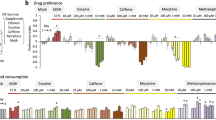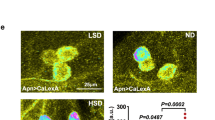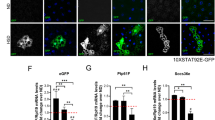Abstract
The insulin signaling pathway regulates multiple physiological processes, including energy metabolism, organismal growth, aging and reproduction. Here we show that genetic manipulations in Drosophila melanogaster that impair the function of insulin-producing cells or of the insulin-receptor signaling pathway in the nervous system lead to increased sensitivity to the intoxicating effects of ethanol. These findings suggest a previously unknown role for this highly conserved pathway in regulating the behavioral responses to an addictive drug.
This is a preview of subscription content, access via your institution
Access options
Subscribe to this journal
Receive 12 print issues and online access
$209.00 per year
only $17.42 per issue
Buy this article
- Purchase on Springer Link
- Instant access to full article PDF
Prices may be subject to local taxes which are calculated during checkout



Similar content being viewed by others
References
Wolf, F.W. & Heberlein, U. J. Neurobiol. 54, 161–178 (2003).
Moore, M.S. et al. Cell 93, 997–1007 (1998).
Park, S.K., Sedore, S.A., Cronmiller, C. & Hirsh, J. J. Biol. Chem. 275, 20588–20596 2000).
Thiele, T.E. et al. J. Neurosci. 20, RC75 (2000).
Rodan, A.R., Kiger, J.A. Jr. & Heberlein, U. J. Neurosci. 22, 9490–9501 (2002).
Brogiolo, W. et al. Curr. Biol. 11, 213–221 (2001).
Rulifson, E.J., Kim, S.K. & Nusse, R. Science 296, 1118–1120 (2002).
Brand, A.H. & Perrimon, N. Development 118, 401–415 (1993).
Chen, C., Jack, J. & Garofalo, R.S. Endocrinology 137, 846–856 (1996).
Tatar, M. et al. Science 292, 107–110 (2001).
Bohni, R. et al. Cell 97, 865–875 (1999).
Weinkove, D., Neufeld, T.P., Twardzik, T., Waterfield, M.D. & Leevers, S.J. Curr. Biol. 9, 1019–1029 (1999).
Junger, M.A. et al. J. Biol. 2, 20 (2003).
Figlewicz, D.P. Semin. Clin. Neuropsychiatry 8, 82–93 (2003).
Acknowledgements
We thank E. Rulifson, M. Jünger and E. Hafen for providing fly strains prior to publication. This work was supported by US National Institutes of Health grants AA10035 and AA13105, and by the McKnight Foundation for Neuroscience.
Author information
Authors and Affiliations
Corresponding author
Ethics declarations
Competing interests
The authors declare no competing financial interests.
Supplementary information
Supplemantary Fig. 1
Inhibition of PKA in IPCs does not cause alterations in ethanol pharmacokinetics. Ethanol levels were measured in extracts of flies of the indicated genotypes (see Supplementary Methods for details). Ethanol exposure is continuous starting at time = 0. (JPG 60 kb)
(n = 3 for all genotypes.) One-way ANOVA across each time point, with the critical p value adjusted to α = 0.01, did not reveal significant differences between the genotypes at any of the five time points (P > 0.05).
Rights and permissions
About this article
Cite this article
Corl, A., Rodan, A. & Heberlein, U. Insulin signaling in the nervous system regulates ethanol intoxication in Drosophila melanogaster. Nat Neurosci 8, 18–19 (2005). https://doi.org/10.1038/nn1363
Received:
Accepted:
Published:
Issue Date:
DOI: https://doi.org/10.1038/nn1363
This article is cited by
-
Intranasal Insulin: a Treatment Strategy for Addiction
Neurotherapeutics (2020)
-
Insulin/IGF signaling in Drosophila and other insects: factors that regulate production, release and post-release action of the insulin-like peptides
Cellular and Molecular Life Sciences (2016)
-
Insulin-producing cells in the brain of adult Drosophila are regulated by the serotonin 5-HT1A receptor
Cellular and Molecular Life Sciences (2012)
-
Drosophila melanogaster as a model to study drug addiction
Human Genetics (2012)
-
The Relationship of Appetitive, Reproductive and Posterior Pituitary Hormones to Alcoholism and Craving in Humans
Neuropsychology Review (2012)



